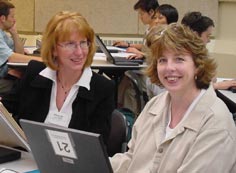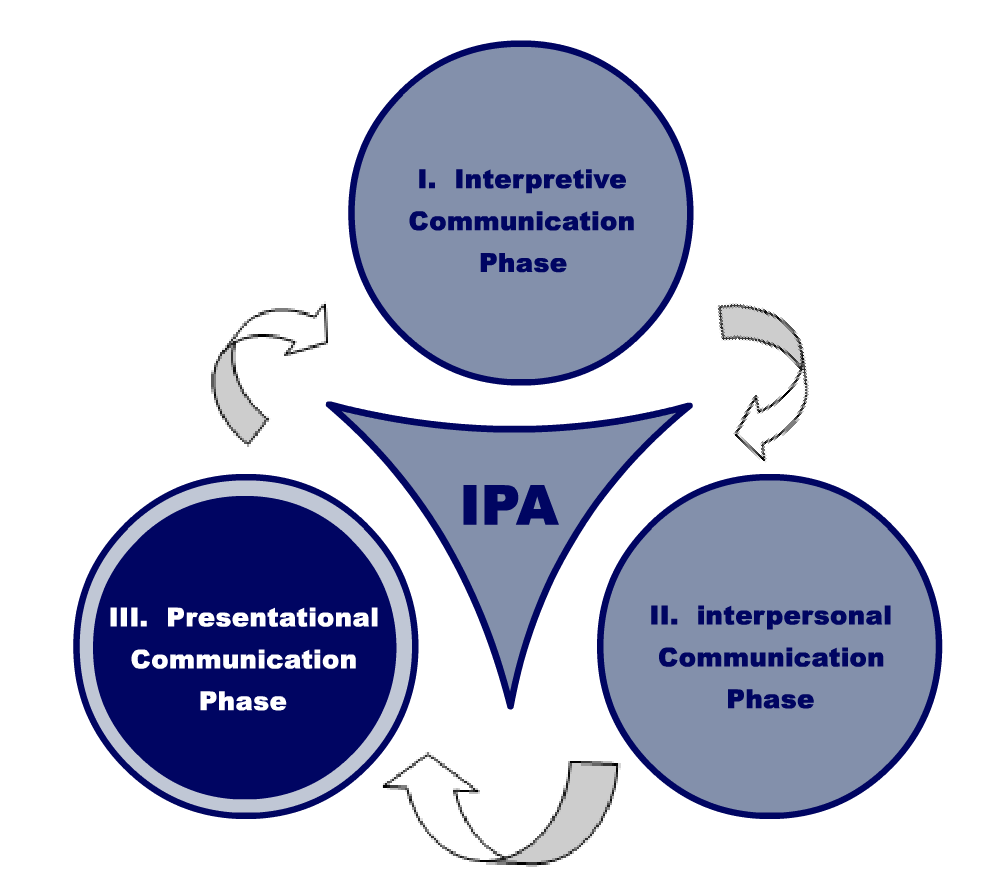 |
|
||||

|
Example 5: The European Union by Pam Wesely Phase 2: Presentational Task Materials needed:
Description of the task: The Presentational Task will allow the students to expand their knowledge of one individual country in the European Union while they are scaffolding their knowledge for the Interpersonal Task during their peers' presentations. In this sense, the Presentational Task is perfectly situated to build upon one task (the general knowledge about the countries in the European Union assessed in the Interpretive Task) and provide a foundation for the next (the specific knowledge required in the Interpersonal Task). They will all be distributed documents in English and French from several sources about their countries. These documents, from the French source L'atlas géographique mondiale http://www.atlasgeo.ch (Gross, 2005), and the English sources Information Please, http://www.infoplease.com (Pearson Education, 2005) and National Geographic, http://plasma.nationalgeographic.com/mapmachine (National Geographic Society, 2005), will give them enough information. I will then give the students these verbal instructions in English:
I will also provide this information to the students in written form in a short handout. With this, I will give the students a copy of the rubric that I will use to evaluate their presentations and their peer assessments (see Appendix C). The rubric is centered around the guidelines I describe in the introduction to the task. When students see the rubrics before their tasks, as Glisan et al. state, "students …monitor their own progress, set realistic goals for themselves…constantly work on improving their performance…[and] understand their roles and responsibilities in the language learning process " (p. 27). The students will have two class periods and two homework evenings to work on this task. On the third day, they will present their work. During the two preparation days, the students will decide on the information that they will present, they will translate unknown words and prepare the written and oral work, and they will practice. I will circulate continuously to help the students work out their linguistic difficulties. I will also keep writing key phrasings and helpful vocabulary hints on the board as the students ask questions. I will emphasize and re-emphasize the importance of comprehensibility in how the written and oral presentations interact in front of the audience. However, students will of course have some latitude in figuring out which five "important" things they would like to share about their country. I would direct them while keeping in mind the words of Underhill (1987) in his discussion of topic choice in oral reports: "Ideally, the topic should be chosen by the learner in consultation with his teacher who will help match the ability of the learner with the difficulty of the given topic" (p. 47). That is, in this context, if a student chooses to speak about a challenging point (like primary exports, for example), I will have to consult with them to find out if they can find a way to present it where the audience will understand (using pictures of the exports). If they cannot, I will redirect them to an easier topic. Additionally, during these two days of preparation, I will be taking notes about what the students are going to present. These notes will help me be responsive to the students' work, in that they will provide the basis for a peer listening guide for the students to complete during others' presentations. More specifically, I will take notes on the general categories that will be covered by students in their presentations. Some examples might include: country capitals, population, type of government, languages spoken, or exports (see Appendix D for a sample page). I will probably omit categories that would require students to write too much in the short interval of the presentation. This listening guide will be written in French, but it will be clearly linked to the presentations because it will be based on my notes. Furthermore, the presenters' visuals will help the rest of the class understand what they are covering. This guide will have three primary functions: to ensure that students pay attention during others' presentations, to give me a way to assess how well they understand (assessing the guide writer as well as the presenter), and to provide students with a base of information for the interpersonal task. This guide will be reflected in the rubric in two ways: I will assess if the guide writer took generally good notes in the non-negotiables, and I will include in the "Comprehensibility" trait of the presenters' rubrics a consideration of how well the students were able to report on their presentations on the listening guides. I will encourage students to do their best in filling out the guides, although they will not be allowed to stop the presentation to ask questions. As I have already mentioned, as the students give their presentations, I will fill out the rubric (Appendix C). They will see the completed rubric after all of the presentations are over and I have had a chance to assess the listening guides as well. There are a few more things worth explaining in this rubric. First of all, process is not considered extensively in how this task is evaluated, therefore it is only featured in the rubric's non-negotiable of "You worked steadily and maintained focus during class." The students are completing a task that is not extremely complex, and spending time on draft work rather than informal correction would emphasize detail over message, also bypassing the communicative nature of the activity (Cohen, 1994). I feel that it is appropriate to evaluate their preparation informally without collecting drafts. Secondly, since the visual presentation is primarily a support for the oral presentation, it is assessed only in terms of how it supports the oral work and helps to transmit the message. When I hand back the scored rubrics (hopefully the day
after the presentations are over and at the beginning of the Interpersonal
Task), I will review them with the class as a whole. Due to the nature
of the Interpersonal Task and the fact that it builds so directly on
the Presentational Task, it is important that I have a chance to review
common errors and answer questions on the part of the students. Additionally,
in forcing myself to assess the presentations that quickly, I will identify
weaknesses in students' work and opportunities to help them further.
This fits in the IPA Manual's feedback loop, wherein practice and performance
lead back to feedback, which will lead, in the start of the Interpersonal
Task, to modeling and practice again (2003, p. 23).
Navigation: Follow the IPA process or go directly to the section that is of most interest to you by clicking on the appropriate category
|
||||
